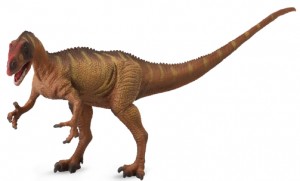A Review of the 1:40 Neovenator Dinosaur Model from CollectA
“New Hunter” Dinosaur Model from CollectA – A Review
It is always a pleasure to see a new scale model of a meat-eating dinosaur introduced into the CollectA dinosaur model range and it is a treat to see a British prehistoric animal featured. That is exactly what has happened with the launch of the CollectA 1:40 scale replica of Neovenator (New Hunter). Team members at Everything Dinosaur review the new CollectA Neovenator dinosaur model.
CollectA Neovenator Dinosaur Model
Known from a seventy percent complete skeleton excavated from a secret location on the Isle of Wight, (southern England) Neovenator is described as a basal member of the Carcharodontidae, although that is disputed by a number of scientists. Although the holotype material is very complete, especially for a European, meat-eating dinosaur; as normally the fossilised bones of these theropods are extremely rare, the taxonomic picture is somewhat confused by the amount of potential Neovenator fossil material from the Wealden succession from the English mainland ascribed to Megalosaurus.
The 1:40 Scale Model of Neovenator (CollectA Dinosaurs)
Picture credit: Everything Dinosaur
It certainly was an apex predator, stalking herds of Iguanodons and Hypsilophodons amongst the horsetail beds and seed ferns of what was a flood plain, criss-crossed by meandering rivers in the Early Cretaceous of western Europe. Estimated to have reached lengths in excess of eight metres and weighing more than 1.5 Tonnes, Neovenator was a formidable predator.
A Formidable Predator
It probably had an “S-shaped” neck which supported a long, snout and jaws lined with sharp, re-curved teeth. The lower jaw was quite delicate, whilst the muzzle was relatively large and robust. The naris (nostrils) were particularly large and this suggests that this dinosaur had an acute sense of smell, perhaps it used this sense to “sniff” out potential prey amongst the dense vegetation of its lowland, flood plain home. Relatively lightly built for its size, more than half the length of this animal is made up of a long muscular tail, it is thought that Neovenator may have been a speedy runner, perhaps hunting in packs to ambush and bring down slower moving large prey animals such as iguanodonts or even sauropods. No actual arm bones or bones from the hand have been ascribed to this genus. It is most likely that this meat-eating dinosaur had relatively short arms which ended in three-fingered hands, with each figure armed with a sharp claw. Some interpretations of Neovenator give this dinosaur slightly larger forelimbs than seen in other replicas of dinosaurs that were in the clade Allosauridae.
To view Everything Dinosaur’s range of dinosaur models including the CollectA Age of Dinosaurs range: CollectA Dinosaur and Prehistoric Animal Figures.
The CollectA Neovenator model is well balanced and depicts Neovenator as a lightly built predator with relatively long forelimbs and a long tail. The model is painted a light tan on the flanks, intertwined with darker strips down the back and the along the length of the tail. In common with many models in the CollectA range this replica depicts Neovenator with its mouth open, perhaps it is just about to roar or attack an unsuspecting ornithopod.
The three-fingered hands are a little over-sized in relation to other 1:40 scale replicas in this series, we shall have to wait for more fossil discoveries before the accuracy of this aspect of the model can be determined. The fingers on each hand are rather splayed out in a slightly unrealistic pose, but at least this gives the model makers the opportunity to show the enlarged second finger, an attribute of most members of the Allosauridae.
Measuring a little over twenty-seven centimetres in length and with a head height of eleven centimetres, we would estimate the scale to be approximately 1:35 (in comparison with the known fossil material).
This is an excellent model of a British meat-eating dinosaur, the figure even comes with a plastic model of a palaeontologist so that the scale of the dinosaur can be appreciated.


